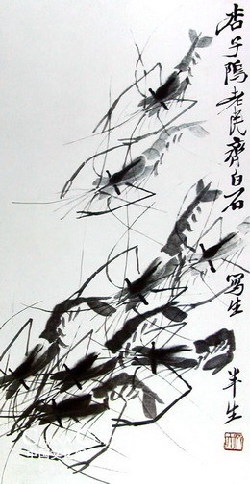Qi Baishi and his paintings with unique style
With this idea in mind, Baishi’s works feature the natural style, which are based on his life. The subjects of his paintings include almost everything, commonly animals, scenery, figures, toys, vegetables, and so on. Even though Baishi wasn’t the first artist to focus on small things in nature, he was acknowledged for his very beautiful and unique way of painting such common images.
Some artists praised him for his “freshness and spontaneity that he brought to the familiar genres of birds and flowers, insects and grasses, hermit-scholars and landscapes”.
One of Baishi’s earlier series of works — “The Carp” was praised because of its simple style without any excessive decorations or writings.
After the fall of the Qing Dynasty, Qi Baishi was known for not being too affected by the politics of the day. Through the harsh times, he kept his own values when practicing arts.
Qi also theorized in a painting of loquat that: “Painting must be something between likeness and unlikeness. If it’s much like the reality, the painting is vulgar, but if it’s not like the reality, the painting cheats the mass.”
He is especially good at describing shrimps. The spirit of shrimp and the way it floats above water are vividly illustrated with a little amount of ink.
 |
|
A Painting of Shrimps |
Many paintings by Qi have smart and humorous titles and inscriptions, expressing his views of life. One painting of two chicks fighting for one angleworm is titled "Friends in the Past". A painting of cooked crabs on a plate has the inscription, “Why don’t you move?” This implies Qi’s dislike for imperious or domineering people, which a crab symbolizes in Chinese culture.
 |
|
"Friends in the Past" |
Although Qi Baishi did not have any formal education or training in the field of art, he mastered many different techniques including calligraphy and seal-carving.


















